Bearing in mind that the source is BW limited, it's possible that a super tweeter is improving the transfer function of the system
PAL systems were 25 frames per second, NOT 30.
You are probably right. IIRC, UK mains was 50 Hz. US mains was 60 Hz.
This is such ancient history to me, that I really don't care. PAL - Wikipedia.
What was staggering, for those of us who now understand Physics, is that we spent 6 hours a day gazing into a TV which was an X-Ray Generator. In a nutshell, anything above 15kV is X-ray. Your own dentist runs a mile from X-Ray exposure these days. Known as cancerous.
To the credit of the TV designers, they built Lead screening into the front glass, but that did little for the person sitting opposite, as happened in PC installations in the 1980's.
Honestly, what with Lead Tetra-ethyl inhalation, X-Rays and Asbestos and Mercury exposure, I surprise myself in still being alive! 😱
Maybe supertweeters are the least of our problems. Certainly I worry about plastic bottles more. 😀
There is no evidence that radiation from TV sets has resulted in human injury - unless they regularly watch Eastenders! 😀...for those of us who now understand Physics, is that we spent 6 hours a day gazing into a TV which was an X-Ray Generator.
P.S. 625 x 25 = 15,625 - so your basic premise was correct.
I have often found the 15K video flyback tone in opera recordings. Not sure why it's common there, unless the crew are watching football during the recording sessions. 🙂
Early SSL mixing consoles were fitted with a CRT monitor (for viewing the automated mixdown fader levels) IN the center mixdown module area, and the ~15K Horizontal frequency DEFINITELY leaked into the stereo buss. Subsequent models did NOT have this "feature".
Hmm so just to stick to the original topic, we don't really need to cover freqs. above ~20K or so, right ? 🙄
Music is a harmonic construct. We call it Timbre, a combination of fundimental + harmonics that gives each instrument it's unique sound. Some of those harmonics can, in real life, get beyond 20khz. There is, thus, a certain logic in believing that not reproducing those harmonics can (and it does) affect the timbre of the instruments.
Most musical instruments never get over 4186 hz which is the highest note on a standard piano keyboard.
But most recordings are limited to the medium they are burned into ... 16khz for Vinyl or tape, 22khz for CDs, 24khz for DVD and BluRay.
Now consider that your average adult seldom hears much over 15khz and that rolls off with age.
If you had a super-tweeter starting at about 13khz it is unlikely that it would ever produce anything that is clearly audible.
Well, my Lincoln Walsh super-tweeters are crossed at 10KHz. My hearing is probably barely that, but they DO make a difference to my ears. Perhaps it's the dispersion due to their vertical orientation; I don't know.
Well, my Lincoln Walsh super-tweeters are crossed at 10KHz. My hearing is probably barely that, but they DO make a difference to my ears. Perhaps it's the dispersion due to their vertical orientation; I don't know.
Most people can hear 10khz and there is musical content at those frequencies, so I'm betting it does.
I believe that even though we don't hear frequencies past 20khz those frequencies can change the sound of the frequencies we do actually hear.
and quoting Blake:So supertweeeters are only usefull to cover the 10kHz to 20kHz spectrum, all above is mainly hype.
And considering that the reproduction equipment is designed stand-alone from la maison as to be flat 20-20 kHz BW ...But most recordings are limited to the medium they are burned into ... 16khz for Vinyl or tape, 22khz for CDs, 24khz for DVD and BluRay.
Now consider that your average adult seldom hears much over 15khz and that rolls off with age.

On my own, I got that supertweeter. I thought that I crossed it at about 10 kHz, and I believe it plays from 10 to 20 k. The mid is believed to play till 15 k ( and I killed the residual 5 k excess with a coil)
So it must play 5 kHz at -12 dB, due to second order filter law
The other extreme is limited mechanically, and now it reminds me the ringing that some metal domes are said to suffer. It may be outrageous to your ears to get exposed to 35 kHz notes! It reminds me also the two quoted messages at the beginning 😉
Pianos produce a multitude of frequencies over 4186---that is the highest FUNDAMENTAL but the harmonics are well above that. Many instruments actually produce 2nd harmonics that are more prevalent than the fundamental.Most musical instruments never get over 4186 hz which is the highest note on a standard piano keyboard.
But most recordings are limited to the medium they are burned into ... 16khz for Vinyl or tape, 22khz for CDs, 24khz for DVD and BluRay.
And, again, tape is NOT limited to 16 KHz---where in the world did you get that? My Ampex ATR-100 analog tape recorder extends easily to 30 KHz.
One week ago I was listening to a piano, and after a few minutes I was thinking that my system lacked a lot on the midbass. Then I realized that the tone control was ON and it had the bass decreased by half and the treble liftted, probably the hip-hop record that I put that saturday evening 🙂
This is certainly one of the most thought-provoking threads we have had for a long time.
The Spendor BC1 was a legendary classical music speaker:
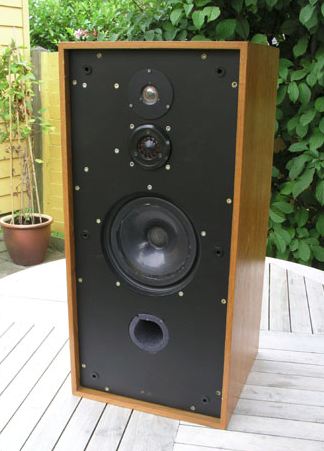
And we are lucky that Troels Gravesen has done such a brilliant analysis:
Spendor BC1
And even an homage to it:
SP38/13
planet10 has me interested in this MarkAudio CHN-50 as a tweeter that can cross low, requiring a small 1L enclosure, but not hard, I think: CHN-50 full range driver | KJF Audio
Supertweeter might be a Spendorish SEAS 22TFF: H1280-06 22TFF
Spoilt for choice on woofers. I've always wanted to try the Vifa PL17WJ polycone:
https://www.falconacoustics.co.uk/drive-units-1/vifa-p17wj0008-woofer.html
Ought to be very good, IMO.
Mark's Pages › Letter from Spencer HughesDear Sir,
The Spendor BC1 was not, as it has so many times been described, a development of the BBC loudspeaker type LS3/6. Perhaps a short history of the lead into, and the development, of the two systems may be of interest.
From the very early days, even before hi-fi, the BBC has designed its own monitor loudspeaker systems as commercial systems were not, and most are still not, accurate enough for broadcast work. These designs were based on available units matched by, what were in those days, very complex crossover networks and mounted in custom designed cabinets.
During the mid-1960s, the development work carried out by the BBC had advanced to a stage which was beyond the capabilities of the available paper pulp cone bass units. The decision was taking to investigate the possibilities of using some form of plastic as a cone and surround material. It was assumed that plastic would be a consistent material unlike paper pulp, which to some degree seemed to depend on the mood of pulp stirrer. Over the years it has been found that it was not quite that easy.
The section of the BBC Research Department involved in this operation was headed by Mr. Del Shorter, now retired, with Mr. H.D. Harwood now of Harbeth Acoustics, second in command and myself completing the investigating team.
Some two years were spent making 12in unit cones in a variety of shapes and from a range of plastics; this could be a story on its own. The first successful unit was made from the now well-known Bextrene and used in the development of the BBC studio monitor type LS5/5. his loudspeaker was described in an article written by Mr. H.D. Harwood in the March 1968 issue of Wireless World.
My part, as a laboratory technician, in the operation was to do most of the actual work both on the plastic investigation and the development of the LS5/5. With that experience I decided that it should be possible to make a loudspeaker from scratch in the home environment. With the aid of our electric fire, a compressor working in reverse and an iron bedstead the first vacuum former was built. Bins full of malformed cones were produced before any measure of success was achieved and the first 8in unit was produced. This unit turned out to be almost certainly the first commercial 8in Bextrene driver and still arguably the best.
The first pair of BC1s was constructed using these units and Celestion HF1300 units. The cabinets were smaller than the current model and initial listening tests indicted that the performance could be improved by an increase in size, hence the present design. At this point it was all being done for fun.
The second pair of BC1s was made for a friend who took them to Merrow Sound of Guildford. The third pair was sold to Merrow Sound and Spendor was on the way to a small niche in the audio world.
Now some difficulties were beginning to arise as under the terms of my contract with the BBC, the design had to be offered to them. Fortunately the 'Pop' era had just started and the main request was for more power, so the BC1 was turned down. Around about this time there was a special requirement within the BBC for one pair of speakers about the size of the BC1s. Being a kind soul, I suggested that my design could be used, so I was given the task of producing an official version of the BC1, later designated the LS3/6.
This design used an 8in unit made by Research Department, the Celestion HF1300 and a redesigned crossover. The main change in the crossover was the addition of a large multi-tap autotransformer to allow adjustment of levels between the two units, normal BBC practice at that time.
Some months later BC1s were fitted with an amplifier mounted in the back panel and the 4001G super tweeter added. This addition was for purchase tax reasons, but it did have two extra gains. Firstly, it improved the overall dispersion characteristics, secondly, from the broadcasting angle, it made any 625-line breakthrough to be more easily detected.
Now the LS3/6 was offered to a number of commercial companies and eventually taken by Rogers, then under the control of Jim Rogers. With approval, and a little assistance from the BBC, Rogers added the Celestion HF2000.
As Spendor was now a commercial company it was agreed that a royalty should be paid to the BBC for each BC1 produced. This was in recognition of the work I had done on the loudspeaker whilst still employed by the BBC.
To perhaps prove the order of development of the two systems, it is of note that out of over two thousand BC1s supplied to the professional market there are over six hundred in operation with the BBC and as far as I know very few, if any, LS3/6 speakers.
In addition to the above, the name Spendor is derived from the first names of myself and my wife Dorothy. Mrs. Hughes provided practical assistance in the early days with her coil winding expertise and now as Managing Director is responsible for all accounting, sales and general management. Derek Hughes, the son, another ex-BBC employee, deals with an amplifier design and assists me with research and development and general running of the factory.
Yours,
Spencer Hughes
The Spendor BC1 was a legendary classical music speaker:
And we are lucky that Troels Gravesen has done such a brilliant analysis:
Spendor BC1
And even an homage to it:
SP38/13
planet10 has me interested in this MarkAudio CHN-50 as a tweeter that can cross low, requiring a small 1L enclosure, but not hard, I think: CHN-50 full range driver | KJF Audio
Supertweeter might be a Spendorish SEAS 22TFF: H1280-06 22TFF
Spoilt for choice on woofers. I've always wanted to try the Vifa PL17WJ polycone:
https://www.falconacoustics.co.uk/drive-units-1/vifa-p17wj0008-woofer.html
Ought to be very good, IMO.
It's certainly got me thinking why you've posted that long letter from Spencer Hughes for a second time (see post #15).This is certainly one of the most thought-provoking threads we have had for a long time.
I may be a dinosaur, but you won't find me repeating myself! 😉
It's certainly got me thinking why you've posted that long letter from Spencer Hughes for a second time (see post #15).
I may be a dinosaur, but you won't find me repeating myself! 😉
IMO it is not the FR above what we can hear, but the (horizontal) off axis response (indirect sound) because of their smaller size (width) and more detail because of lower weight of the moving parts, which make the difference.
I use the tiny dayton mini planar tweeters crossed at 5kHz to 2 or 4 visaton frs8m 3.3" broadband drivers and even though on axis FR with and without the tweeter look pretty much the same, the SQ is worlds apart; way bigger sound stage, more detail and 'air'. Like a veil is removed.
I can't hear a difference if I use a 16kHz high cut filter or not.
So to me tweeters starting at 20kHz are nonsense until I experience otherwise.
TAKET|Super Tweeter|BATPURE
You can even use them on your headphones........ 🙄

" [SIZE=-1]Left photo is an open-type dynamic headphone.
BATPURE can be attached with a strong double-faced tape on
the cover of the vibration board, and connected with
the dynamic-unit of headphone in parallel.
[/SIZE] [SIZE=-1]Right photo is external of headphone.
The slide switch is put on to test ON-OFF.of effect.
Even if you are not a person who is aurally sensitive to the sound
change, if you turn on BATPURE, your neck and body
will be shaken naturally regardless of the kind of music."
[/SIZE]
Are they bass bat tweeters? 😛
There is also a "BatPro Supertweeter" which I could not find on their website but in this review and an explanation is given on why they should work.
"When we got to the subject of super tweeters, and why they should work even though we can't hear most of their output, a somewhat bored and by now condescending organ builder asked (in Dutch) if we had not heard of harmonics. Eventually the penny dropped. Harmonics go both up and down and sounds interact with other sounds to form more harmonics both up and down the scale, growing softer at each (re)iteration.
A simple demonstration of a “cheat” used by organ builders over hundreds of years was enough to convince me that this is why super tweeters work and just maybe another reason why LPs always sound better than CDs. Understand that the example is just one of the effects that happen all the time at varying frequencies and volume levels when we listen to music or anything else.
In an organ the pitch of a note is given as a length in feet. A 16' pitch equates to a fundamental tone of around 32 Hz. The cheat comes here. As an organ pipe 32' long is very expensive, both in material and in air supply, organ builders pull a fast one and make a “quint”. If a note is played and simultaneously a note a 5th above, a strong harmonic of about half volume is developed an octave lower. Over the years organ builders have refined this into something that is fitted to most organs of any size. A couple of good examples of this are the organs in the Royal Albert Hall and Liverpool (Anglican) Cathedral. Both organs have a 64' Gravissima or Resultant stop. This resultant tone of 8 Hz (bottom C) is achieved by playing a 32' combined with a 21 2/3' stop or a 5th above. This effect applies to any and all notes that are sounded together, hence the harmonic richness of organs and the resultant tones react with other tones and fundamentals in a diminishing loudness, both up and down the spectrum.
This effect, or lack of it, can be easily heard in the Wurlitzer Unit organ, where pipes are duplexed or shared. To put that another way, a Theater Organ is harmonically impoverished as compared to a normal straight organ as found in cathedrals, churches and concert halls. But to get back to our simple quint: in a super tweeter a tone is reproduced that is beyond our hearing and that tone mixes and forms lower harmonics that we can hear. Without the super tweeter to reproduce the supersonic tones, no lower harmonic can be formed. The sound of any instrument is rich in harmonics and all of those harmonics, up and down the frequency spectrum, react with any and all of the other tones also up and down. This effect also explains why some people often hear an improvement in the lower frequencies."
I use the tiny dayton mini planar tweeters crossed at 5kHz to 2 or 4 visaton frs8m 3.3" broadband drivers and even though on axis FR with and without the tweeter look pretty much the same, the SQ is worlds apart; way bigger sound stage, more detail and 'air'. Like a veil is removed.
I can't hear a difference if I use a 16kHz high cut filter or not.
So to me tweeters starting at 20kHz are nonsense until I experience otherwise.
TAKET|Super Tweeter|BATPURE
You can even use them on your headphones........ 🙄

" [SIZE=-1]Left photo is an open-type dynamic headphone.
BATPURE can be attached with a strong double-faced tape on
the cover of the vibration board, and connected with
the dynamic-unit of headphone in parallel.
[/SIZE] [SIZE=-1]Right photo is external of headphone.
The slide switch is put on to test ON-OFF.of effect.
Even if you are not a person who is aurally sensitive to the sound
change, if you turn on BATPURE, your neck and body
will be shaken naturally regardless of the kind of music."
[/SIZE]
Are they bass bat tweeters? 😛
There is also a "BatPro Supertweeter" which I could not find on their website but in this review and an explanation is given on why they should work.
"When we got to the subject of super tweeters, and why they should work even though we can't hear most of their output, a somewhat bored and by now condescending organ builder asked (in Dutch) if we had not heard of harmonics. Eventually the penny dropped. Harmonics go both up and down and sounds interact with other sounds to form more harmonics both up and down the scale, growing softer at each (re)iteration.
A simple demonstration of a “cheat” used by organ builders over hundreds of years was enough to convince me that this is why super tweeters work and just maybe another reason why LPs always sound better than CDs. Understand that the example is just one of the effects that happen all the time at varying frequencies and volume levels when we listen to music or anything else.
In an organ the pitch of a note is given as a length in feet. A 16' pitch equates to a fundamental tone of around 32 Hz. The cheat comes here. As an organ pipe 32' long is very expensive, both in material and in air supply, organ builders pull a fast one and make a “quint”. If a note is played and simultaneously a note a 5th above, a strong harmonic of about half volume is developed an octave lower. Over the years organ builders have refined this into something that is fitted to most organs of any size. A couple of good examples of this are the organs in the Royal Albert Hall and Liverpool (Anglican) Cathedral. Both organs have a 64' Gravissima or Resultant stop. This resultant tone of 8 Hz (bottom C) is achieved by playing a 32' combined with a 21 2/3' stop or a 5th above. This effect applies to any and all notes that are sounded together, hence the harmonic richness of organs and the resultant tones react with other tones and fundamentals in a diminishing loudness, both up and down the spectrum.
This effect, or lack of it, can be easily heard in the Wurlitzer Unit organ, where pipes are duplexed or shared. To put that another way, a Theater Organ is harmonically impoverished as compared to a normal straight organ as found in cathedrals, churches and concert halls. But to get back to our simple quint: in a super tweeter a tone is reproduced that is beyond our hearing and that tone mixes and forms lower harmonics that we can hear. Without the super tweeter to reproduce the supersonic tones, no lower harmonic can be formed. The sound of any instrument is rich in harmonics and all of those harmonics, up and down the frequency spectrum, react with any and all of the other tones also up and down. This effect also explains why some people often hear an improvement in the lower frequencies."
Last edited:
I only reposted the very interesting Spencer Hughes letter to get latecomers up to speed on the Spendor BC1. Which is an early superetweeter design. 🙂
Mr.Think is doubtless right on the dispersion problem it solves at HF. I have simmed that FRS 8 M often enough. It does good things, but will beam considerably at HF
FRS 8 M - 8 Ohm | Visaton
And there's no escaping the physics of cones, they break up into distortion at a certain point. It's just cone-geometry. An alarming analysis of cone problems at Klippel:
https://www.klippel.de/fileadmin/klippel/Files/Know_How/Literature/Papers/KLIPPEL_Cone_Vibration_Poster.pdf
This cone tweeter style, An AR-4 is close to my heart:
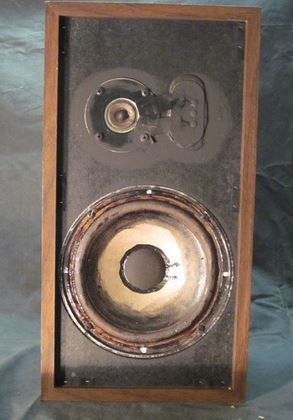
But off-axis, it is terrible. But cone tweeters do sound very smooth if rolled off at HF with a coil of, say, 0.3mH. Enter a supertweeter, IMO. It will be in its comfort zone around 10kHZ crossover, for sure.
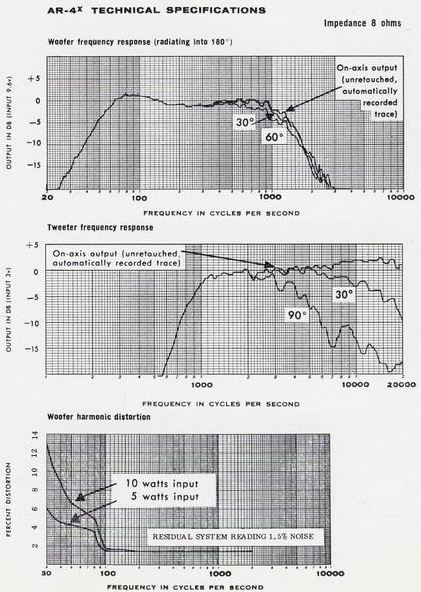
I was looking at some 19mm tweeters. This SB Acoustics is remarkable off-axis. And a smallish 88mm. Cheap too. About £17 in the UK:
SB19ST-C000-4 :: SB Acoustics
Mr.Think is doubtless right on the dispersion problem it solves at HF. I have simmed that FRS 8 M often enough. It does good things, but will beam considerably at HF
FRS 8 M - 8 Ohm | Visaton
And there's no escaping the physics of cones, they break up into distortion at a certain point. It's just cone-geometry. An alarming analysis of cone problems at Klippel:
https://www.klippel.de/fileadmin/klippel/Files/Know_How/Literature/Papers/KLIPPEL_Cone_Vibration_Poster.pdf
This cone tweeter style, An AR-4 is close to my heart:
But off-axis, it is terrible. But cone tweeters do sound very smooth if rolled off at HF with a coil of, say, 0.3mH. Enter a supertweeter, IMO. It will be in its comfort zone around 10kHZ crossover, for sure.
I was looking at some 19mm tweeters. This SB Acoustics is remarkable off-axis. And a smallish 88mm. Cheap too. About £17 in the UK:
SB19ST-C000-4 :: SB Acoustics
Last edited:
Thanks for that interesting Klippel poster on Loudspeaker Cone Vibration.And there's no escaping the physics of cones...
The off-axis response of a Fostex T500 horn super tweeter is shown in the spec sheet below for comparison to that of the AR-4X cone tweeter to which you referred:
https://www.fostexinternational.com/docs/speaker_components/pdf/t500ammk2.pdf
TBH, I am not a fan of bullet tweeters at all:
https://www.fostexinternational.com/docs/speaker_components/pdf/t500ammk2.pdf
We all have the occasional disaster in our careers. My own was matching a 12" Goodmans PA woofer to an aluminium bullet tweeter. The sound was VICIOUS. Sure it went loud, but seemed to drill a hole in my ear if you were unfortunate to be on-axis! Anything horn-loaded tends to highly directional.
Much as there is to like about the hugely efficient Wharfedale E70, that bullet tweeter was its weak spot, IMO.
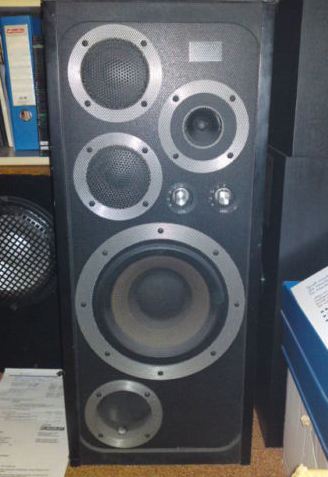
Where I am currently going on this, is actually more on planet10's ideas.

I just look at that, and from experience think it needs a supertweeter! Because I don't think a 2" tweeter behaves particularly well above 10kHz. Anathema to our beloved Dave, but we are, after all, multi-way. 😀
Possibly a bit of mission-creep here, but the Gale 401 worked well enough too:
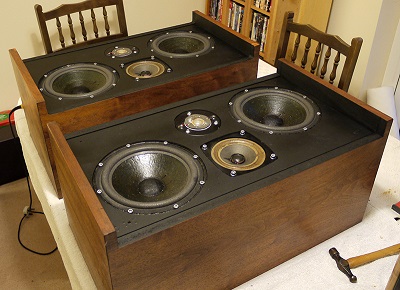
At least shows another goodish idea.
https://www.fostexinternational.com/docs/speaker_components/pdf/t500ammk2.pdf
We all have the occasional disaster in our careers. My own was matching a 12" Goodmans PA woofer to an aluminium bullet tweeter. The sound was VICIOUS. Sure it went loud, but seemed to drill a hole in my ear if you were unfortunate to be on-axis! Anything horn-loaded tends to highly directional.
Much as there is to like about the hugely efficient Wharfedale E70, that bullet tweeter was its weak spot, IMO.
Where I am currently going on this, is actually more on planet10's ideas.

I just look at that, and from experience think it needs a supertweeter! Because I don't think a 2" tweeter behaves particularly well above 10kHz. Anathema to our beloved Dave, but we are, after all, multi-way. 😀
Possibly a bit of mission-creep here, but the Gale 401 worked well enough too:
At least shows another goodish idea.
Last edited:
The whole concept sounds batty to me! 🙂Are they bass bat tweeters? 😛
P.S. Re the explanation you included of how super tweeters may work, I mentioned difference tones (aka combination tones) at the beginning of this thread.
If an audible tone of 12kHz is played along with an ultrasonic tone of 22kHz then an audible, if subtle, difference tone of 10kHz can be heard.
Combination tones: Demonstrating the nonlinearity of the human ear
Pianos produce a multitude of frequencies over 4186---that is the highest FUNDAMENTAL but the harmonics are well above that. Many instruments actually produce 2nd harmonics that are more prevalent than the fundamental.
Indeed that is true. Some harmonics get well over 20khz in live performances. Most instruments are harmonically rich like that.
BUT ... that only translates to the playback experience if those harmonics are actually recorded and they seldom are. You can't reproduce what isn't in the recording.
And, again, tape is NOT limited to 16 KHz---where in the world did you get that? My Ampex ATR-100 analog tape recorder extends easily to 30 KHz.
I didn't say it was. I said that when mastering it is common for Vinyl and Tape to be limited to 16khz. The reasons for this are complex, relating mainly to stereo decoder pilots in FM broadcasts and the dynamic range signals in old-school Dolby compression.
Once again ... you cannot reproduce what isn't there.
Last edited:
The problem with the supertweeter appears if it is a later addition to an already built box, for example, with a single full-range speaker.
- Home
- Loudspeakers
- Multi-Way
- Is a 'super tweeter' REALLY noticeable ?